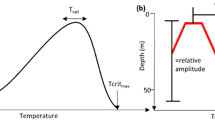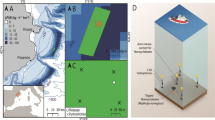Abstract
We measured the horizontal and vertical movements of five adult yellowfin tuna (Thunnus albacares, estimated body mass 64 to 93 kg) near the main Hawaiian Islands, while simultaneously gathering data on oceanographic conditions and currents. Fish movements were recorded by means of ultrasonic depth-sensitive transmitters. Depth–temperature and depth–oxygen profiles were measured with vertical conductivity–temperature–depth (CTD) casts, and the current-velocity field was surveyed using an acoustic Doppler current profiler (ADCP). Large adult yellowfin tuna spent ≃60 to 80% of their time in or immediately below the relatively uniform-temperature surface-layer (i.e. above 100 m), a behavior pattern similar to that previously reported for juvenile yellowfin tuna, blue marlin (Makaira nigricans), and striped marlin (Tetrapturus audax) tracked in the same area. In all three species, maximum swimming depths appear to be limited by water temperatures 8 C° colder than the surface-layer water temperature. Therefore, neither large body mass, nor the ability to maintain elevated swimming-muscle temperatures due to the presence of vascular counter-current heat exchangers in tunas, appears to permit greater vertical mobility or the ability to remain for extended periods below the thermocline. In those areas where the decrease in oxygen with depth is not limiting, the vertical movements of yellowfin tuna, blue marlin and striped marlin all appear to be restricted by the effects of water temperature on cardiac muscle function. Like juvenile yellowfin tuna, but unlike blue marlin and striped marlin, adult yellowfin tuna remained within 18.5 km of the coast and became associated with floating objects, including anchored fish-aggregating devices (FADs) and the tracking vessel. Like juvenile yellowfin tuna, large adult yellowfin repeatedly re-visit the same FAD, and appear able to navigate precisely between FADs that are up to 18 km apart. The median speed over ground ranged from 72 to 154 cm s−1. Neither speed nor direction was strongly influenced by currents.
Similar content being viewed by others
Author information
Authors and Affiliations
Additional information
Received: 27 March 1998 / Accepted: 13 November 1998
Rights and permissions
About this article
Cite this article
Brill, R., Block, B., Boggs, C. et al. Horizontal movements and depth distribution of large adult yellowfin tuna (Thunnus albacares) near the Hawaiian Islands, recorded using ultrasonic telemetry: implications for the physiological ecology of pelagic fishes. Marine Biology 133, 395–408 (1999). https://doi.org/10.1007/s002270050478
Issue Date:
DOI: https://doi.org/10.1007/s002270050478




